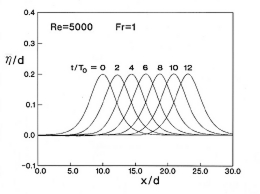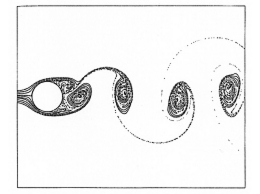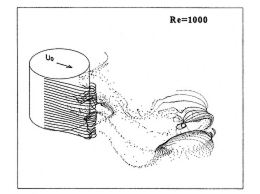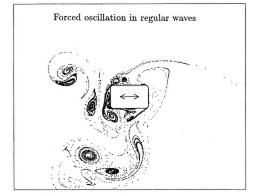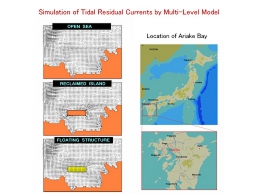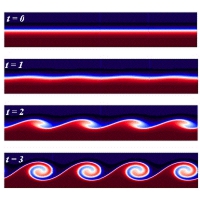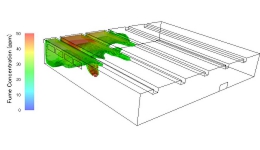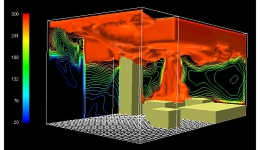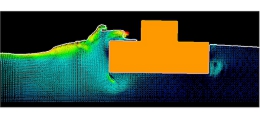I started my CFD research in 1988 when I was a graduate student in Shanghai Jiao Tong University. The graphics shown in this page are selected from my CFD simulation results which are mainly obtained in Kyushu University. I chose one image or movie for each year just for that I think it is the most "beautiful" one in the year. Enjoy and any comment is welcome.
1990
Simulation of Solitary Wave Propagation by SOLA-VOF method。
The figure is scanned from my MS thesis showing a two-dimensional simulation of solitary wave propagation. I was fascinated by CFD for the first time through this computation.
1992
Simulation of Karman Vortex Street from a Circular Cylinder
I started my doctorate research from this year in Prof. Koterayama's Lab., RIAM, Kyushu University. The research thame is applying CFD method to study the hydrodynamic forces on cylindrical members of floating structures. At first I wrote a two-dimensional finite difference program (MAC scheme) using a body-fitted grid system. This figure is an simulation example. Scanned from my PhD thesis.
1993
3-D Simulation of an Uniform Flow Past a Two Dimensional Circular Cylinder
Then I developed a 3D code. This figure shows a simulation result of an uniform flow past a two dimensional circular cylinder. The computation condition is just like that of 2-D simulation in "1992", but it can be found that the wake is totally three dimensional. Scanned from my PhD thesis.
1994
Simulated Flow Pattern for a Horizontal Lowerhull-Type Cylinder at Ur=4
The is a simulation result of two-dimensional simulation, showing the flow pattern of a forced horizontally oscillating lowerhull-type cylinder in regular waves. This calculation was made to demonstrate that the drag force coefficient for such cylinder is sensitive to the vortex shedding patterns. Scanned from my PhD thesis.
1995
Effect of a Floating Airport on Tidal Residual Currents
After I reseived my PhD degree, I worked with Prof. Kyozuka for one year, in developing a CFD code based on Multi-Level model for environmental assessment of a VLFS. The figure shows the comparison of the calculated tidal residual currents of Ariake Bay at top level under the three conditions of no airport, reclaimed airport and floating airport. The effect of a floating airport on the tidal residual current is much less than that of a reclaimed airport.
1996
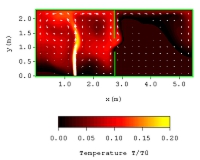
2-D Simulation of Heat Convection from a Compartment Fire
From this year I started a new research project in Prof. Fukuchi's Lab of Kyushu University on numerical prediction of turbulent heat movement from marine fires. At first I made a 2-D program based on time-dependent SIMPLE scheme, in which the k-e turbulence model is used. This figure is a two-dimensional result of Ra=1.5*1012, at time t/t0=70, . The calculation was conducted on a small PC, and a regular mesh(120x50) was used,.
Simulation of a Kelvin-Helmholtz Wave
The figure shows the development of a Kelvin-Helmholtz wave computed by the 2-D SIMPLE based program with higher accuracy upwind scheme for convection terms. No turbulence model was used. Richardson number = 0.07, Reynolds number = 300, Dimensionless disturbance wavenumber = 0.43, Prandtl=0.71. The calculation is carried out in a regular mesh (100x248).
1998
3-D Simulation of Metallic Fume Heat Diffusion in a Fabrication Shop
The time-dependent SIMPLE scheme and k-e turbulence model based program was extended to a three dimensional version including gas concentration transport. This image is a 3-D numerical simulation result on metallic fume movement in a fabrication shop, showing the high concentration area at the time of 5 minutes after the operation of 4 cutting machines.
1999
Largy Eddy Simulation of Rayleigh-Benard Convection
As the computers running CFD programs become very powerful and resonably priced, it is found that conducting large eddy simulation on an engineer problem of turbulent heat convection is possible. A 3-D code was generated based on the fractional step scheme with the sudgrid flunctuations effect represented by Smogrinsky SGS model. This movie is a result of Rayleigh-Benard convection for Ra=2*106 showing the instantanous isosurface of temperature. A mesh with (64x64x64) grid points was used.
2000
LES of Hot Gas Movement from a Passenger Ship Cabin Fire
A LES based CFD fire simulation model was developed in this year. This image is a simulation result of a passenger ship cabin fire, showing the volume occupied by the hot gas over 300 C at the time 3 minutes after the iginition. The heat release rate from the fire is inputed using measured data.
2001
LES of Flame Dynamics
In order to simulate a real fire, a combustion model based on the calculation of gaseous fuel and air mixing is implemented into the CFD model to calculate the heat release rate as well as the position of flame. The movie is a simulation of a 25-cm pool fire with diesel oil, showing the instantaneous flame (isosurface of fuel consumption rate) and the plume (isosurface of a temperature). The three major zones of the fire can be found in the figure: the continuous flame, the intermittent flame and the buoyant plume regions.
2002
Extreme Nonlinear Wave-Body Interaction
From April 1, 2002, I became a member of RIAM, and started a new research project on CFD development for extreme nonlinear wave-body interaction. The CIP (Constrained Interpolation Profile) method is adopted as the basic scheme. The figure shows a snapshot of a 2-D simulation of a floating body with an upper structure, which is restricted horizontally by a spring in a numerical wave tank. The complicated phenomena such as large deformation of free surface, violent motion of floating body, water on deck, vortex shedding are successfully simulated by the method.
2003
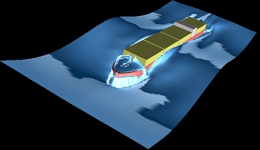
3-D Computation of Water-on-Deck of a Container Ship
The CIP based code was extended to 3D this year. The image is a snapshot of a 3-D simulation of a container ship model moving with a constant speed in large waves. The water-on-deck phenominon is successfully simulated.
2004
Violent Tank Sloshing
In this year, CIP-CSL3 shcheme, a conservative CIP scheme, was implemented to the CFD code. The violent tank sloshing problem was studied by the new code. The CFD movie shows a case of experiment with T =1.3 sec.
2005
Water with 3-D Object
The Virtual Particle Method was developed in this year for treating complicated body. This CFD movie is a demonstration of this method for handling complicated interaction between free surface and 3-D object.
2006
Green Water Impact Simulation
This is a comparison between experiment and CFD on green water impact of a modified Wigley model. The CFD code was given a code name of "RIAM-CMEN" in this year. THINC scheme was used for free surface capturing.
2007
Water Entry with a Short Circular Cylinder
RIAM-CMEN was applied to study the water entry phenomena. This movie is a CFD result on inclined circular cylinder.
2008
A Ship in Extreme Large Waves
This is a demonstration of RIAM-CMEN for extremely nonlinear wave-ship interaction.
2009
Large Container Ship in Waves
This is a practical application of RIAM-CMEN to predict nonlinear wave loads on latest post-Panamax container ship.
2010
6 DoF Motion of Container Ship in Oblique Waves
In order to treat large-amplitude ship motions, e.g., capsizing, the rotation of the body is solved by using quaternion representation. This animation shows a simulation result of a container ship in oblique waves.
2011
Parallel Computation
RIAM-CMEN was parallelized on a PC-cluster system using MPI standard. The CFD movie is a parallel computation result with more than 100 million meshes.
2012
Turbulent Flow past a Bus by Lattice Boltzmann Method
Coupled lattice Boltzmann (LB) scheme and finite volume method (FVM) is developed for large scale simulation of automobile air pollution problems. A subgrid-scale (SGS) model is incorporated for large-eddy simulation (LES) of the turbulence flow. The animations are the exhaust particulate matter movement and the vertex showing the turbulent flow. numerical prediction to simulate.
2013
Numerical Simulation of a Floating Wind Turbine Platform
RIAM-CMEN has been extended for numerical simulation of floating wind turbine platform in harsh sea conditions.

